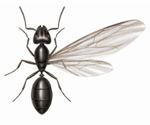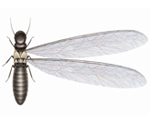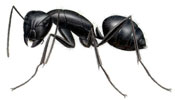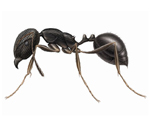Ants & Termites

Ant Swarmer: Winged reproductives produce the offspring in the colony and swarm at certain times of the year. Colonies can have both primary reproductives (one king and one queen), and hundreds of secondary reproductives to assist in egg laying and colony growth. To tell the difference between a winged reproductive termite and a swarming ant, look at the swarmer’s body shape, antennae and length of wings.
ANT: Elbowed antennae, narrow waist, front wings longer than back wings

Termite Swarmer: Straight, beaded antennae, broad waistline, two pairs of wings – equal in size. A “swarm” is a dispersal flight of winged termites to start new colonies.
TERMITE: Straight antennae, thick waist, both pairs of wings same size

Carpenter Ant: These are among the largest of ants and are vicious biters. Workers vary greatly in size from 1/4″ to 3/8″ in length. Usually they are black, but may have some brown coloration. They’re long-legged and move swiftly. Found throughout the United States in a variety of species. The tunnels they excavate in wood are clean, almost sandpapered in appearance unlike termite tunnels

Odorous House Ant: Their body is brown to black, and are approximately 1/16 – 1/8 inch in length. Their antennae have 12 segments and are without a club. They received their name because when crushed they give off a pungent odor.

Pavement Ant: The workers are about 1/16 – 1/8 inch in length and the queen is about 3/8 inch. Their body ranges from light brown to black and their legs and antennae are paler. Their bodies are covered with stiff hairs.
Indoors, the preferred nesting area is ground level, near a heat source, such as heaters, pipes, and machinery. Outdoors, it is most common for them to nest in cracks in the pavement, next to buildings, or under stones. These ants are aggressive and can bite or sting.

Pharaoh Ant: These ants vary in color from yellowish to reddish, with the abdomen normally darker to black. Pharaoh ants are found throughout the United States. There colonies can become very large, numbering in the hundreds of thousands. They prefer to nest in warm, humid areas near a source of food and water.

Subterranean Termite: Winged forms are only 1/2″ long. Workers and soldiers are about 1/4″ long. The soldier has an elongated, quandrangular, light yellow head with straight mandibles, curved at the tip. The thorax of the worker is the narrower than the head and abdomen. The most widespread group of termites. They cause most of the termite damage to structural timbers in the United States.
